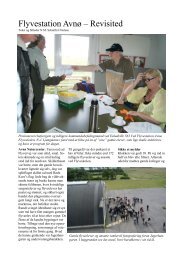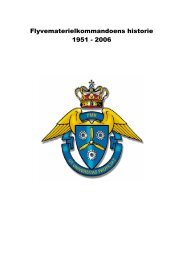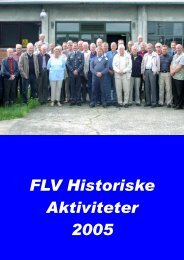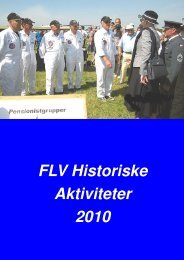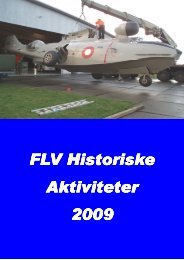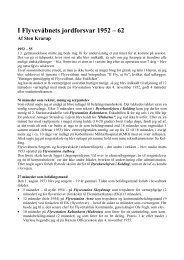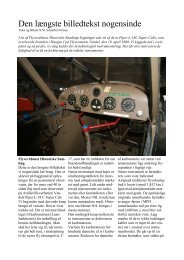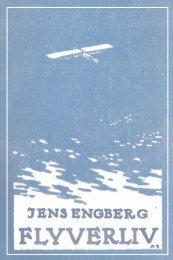CAOC Finderup 1993 - 2013 - Flyvevåbnets Historiske Samling
CAOC Finderup 1993 - 2013 - Flyvevåbnets Historiske Samling
CAOC Finderup 1993 - 2013 - Flyvevåbnets Historiske Samling
- No tags were found...
Create successful ePaper yourself
Turn your PDF publications into a flip-book with our unique Google optimized e-Paper software.
<strong>CAOC</strong> <strong>Finderup</strong><strong>1993</strong> - <strong>2013</strong>1
INTRODUCTIONSince the middle of the twentieth century, coordinated air operations have been carried out over thenorthern part of Europe. Combined Air Operation Centre <strong>Finderup</strong> has played an important part. Sincethe end of WWII, NATO has focused on the area North of Norway and the Baltic Approaches. Thecentralized Air Command for the northern part of NATO was integrated in the Command Structure andthe air defences kept a high alert against a possible WAPA aggression. An important Command Centralwas constructed in a very modern bunker on the moor of <strong>Finderup</strong>, outside Viborg in Denmark. Afterthe end of the Cold War, NATO adjusted and so did the Air Command Structure. <strong>CAOC</strong> <strong>Finderup</strong>became one of the pivotal points in this structure, and its personnel became engaged in the new NATOsecurity environment, from the bunker as well as from deployed sites.This little book will tell the story of more than 20 years of international air operations conducted from<strong>CAOC</strong> <strong>Finderup</strong>. It is a tribute to the men and women who served there over time.Enjoy the readingHENRIK RØBOE DAMCOMMANDER <strong>CAOC</strong>FMajor General2Back to Tables of Contents
TABLE OF CONTENTSIntroduction 2Crest of <strong>CAOC</strong> <strong>Finderup</strong> 3Background 5BALTAP 6Women’s Peace Camp 7Bunker 7 8NATO Air Operations 10NATO AEW Force 11Post-Cold War 11Operation Allied Force andKosovo Force 129/11 13The International SecurityAssistance Force 14New Challenge 14Iceland Air Policing 14Consolidation 15Libya 16The Threat 17Daily Operations 21Exercises 27Social Activities 28Epilog by the Editor 34List of Literature 34The Commanders 35The Manning 37<strong>CAOC</strong> <strong>Finderup</strong> <strong>1993</strong>—<strong>2013</strong>Published by:Flyvevåbnets <strong>Historiske</strong> <strong>Samling</strong>© Copyright:Flyvevåbnets <strong>Historiske</strong> <strong>Samling</strong><strong>2013</strong>Editor:Colonel Søren Falk-PortvedLayout:Bent Aalbæk-NielsenPrint:: Forsvarets TrykkeriISBN: 978-87-92351-06-7The insignia for Combined Air Operation Centre<strong>Finderup</strong> has, at its centre, the sword of ComponentCommand Air Ramstein. Component Command AirRamstein is the Headquarters responsible for all NATOair activities within the Northern Region. To the left andright of this protective sword are the nations: Iceland,United Kingdom, Denmark and Norway, within whoseairspace all NATO air activities is the responsibility of<strong>CAOC</strong> <strong>Finderup</strong> – most important the air policing byNATO Quick Reaction Alert assets as indicated by theaircraft symbol. Three aircraft tracks merge into one tosymbolize the amalgamation of former <strong>CAOC</strong> <strong>Finderup</strong>,<strong>CAOC</strong> Reitan (Norway) and <strong>CAOC</strong> High Wycombe (UK)into <strong>CAOC</strong> <strong>Finderup</strong>. The NATO crest on the top rightindicate the three seas surrounding Denmark, the HostNation from which <strong>CAOC</strong> <strong>Finderup</strong> operates.3
BackgroundOn the peninsula of Jutland, some 20kilometres west of Viborg, lies a sparselypopulated moor in the middle of the Kingdomof Denmark with just a few villages scatteredaround. One small village became worldfamous, when the Danish King, Erik the Fifth,was killed in the church barn of <strong>Finderup</strong> on22 nd November 1286. The village is still there.Today, the area around <strong>Finderup</strong> is a militarytraining ground, and in 1969 was selected tohouse one of NATO´s static militaryheadquarters.The Kingdom of Denmark, situated on the approaches of the Baltic Sea has, throughout time,been of strategic significance. In 1429 a toll was imposed on all shipping passing the narrowstrait of Øresund. For many years the dues paid represented a major part of the King’srevenues. However, under pressure from many major seafaring nations (England, Russia andthe United States of America) the dues were revoked in 1857.5Back to Tables of Contents
BALTAPWhen NATO was formed in 1949, theimportance of the Baltic Approaches wasagain evident. The Iron Curtain divided Europejust to the east and south of Denmark. Controlof the strait was paramount to the NATOnations´ strategic concept, and in 1961 theNATO command “Allied Forces BalticApproaches” (BALTAP) was formed in Karup.The Baltic Sea had clearly become one of thefront lines in the Cold War. BALTAP wasplaced at the third level of NATO command asa Principal Subordinate Command. BALTAPwas given the joint responsibility for theterritories of Denmark, Schleswig-Holstein andHamburg in Germany north of the river Elbe,the entire Baltic Sea, the Danish Straits andpart of the North Sea, plus the airspace abovethese areas.During the Cold War there was specialemphasis on air defence and the dailysurveillance of NATO airspace. The taskincluded air policing with armed missionsagainst violations of NATO airspace andnational airspace. Air defence was and is aminute-to-minute task, whereas other tacticalair operations during the period of the ColdWar were primarily a matter of pre-planningand regular scheduled exercising of assignedair assets.The peacetime headquarters for BALTAPwas situated at Airbase Karup, south ofViborg. In crisis and war there was a need fora hardened facility nearby, for which the areato the north of the Airbase was selected. Themilitary training ground around <strong>Finderup</strong>provided the ideal location. Planning for theconstruction started in 1969 and ground wasbroken in 1977.6Back to Tables of Contents
Women’s Peace Camp at RavnstrupIn the early 1980s, protests against the NATOforces were growing in the peace movementsaround western Europe. In the mobilelaunching platform-mounted SS-20 missilesthe European NATO members saw no less athreat than the strategic intercontinentalmissiles, and on 12 th December 1979, NATOtook the so-calledNATO Double-Track Decision.This decisionintended thedeployment of 572equally mobileAmerican middlerangemissiles(Pershing II andBGM-109TomahawkGryphon Ground-Launched CruiseMissiles).GreenhamCommonWomen's PeaceCamp was apeace campestablished to protest against nuclearweapons being sited at RAF GreenhamCommon in Berkshire, England.The camp began in September 1981 after aWelsh group, Women for Life on Earth, arrivedat Greenham to protest against the decision ofthe British government to allow cruise missilesto be based there. Inspired by the GreenhamCommon Women's Peace Camp and theongoing constructions at <strong>Finderup</strong>, a Women´sPeace Camp was established in July 1984near Ravnstrup, on the outskirts of the buildingsite.The main purpose of the Women's PeaceCamp at Ravnstrupwas to protestagainst the buildingof the NATObunker. Secondly,the protest wasdirected againstthe nuclear armsand the maledominated militarystructure.However, thePeace Camp wasalso a reflection ofthe social trends atthat time. A fewwomen stayedpermanently at thecamp, severalothers stayed onlyfor shorter periods, when direct actions againstthe bunker building were conducted. After theWomen's Peace Camp at Ravnstrup wasabandoned in September 1985, severalstudies were conducted to determine its sociopoliticalimpact, and how: “The Power ofDisobedient Women” changed the world.7Back to Tables of Contents
Bunker 7After almost eight years of construction, thebunker was ready in 1985. It was handed overto NATO on the 19th November 1985 as“Bunker 7”. Except for the small pavilions anda few antennas above ground, very little couldbe seen from the outside and it looked like justanother small hill on the moor.Bunker 7 comprises three decks. Airconditioning, power plant and water facilitiesas well as a cafeteria occupy the bottom deck;air operations are controlled from the middledeck, and communications systems and otheroffices take up the top deck. A 95-stepstaircase gives you access to the middle deckthrough a number of gates and turns. Aservice entrance with a lift gives access to thebottom deck. On top of it all is a number ofprotective layers designed to withstand mostknown weapon types.At the time that Bunker 7 was handed overto NATO in 1985, it was the most modern andsecure facility in the whole of NATO. Submarine-like,it wasbuilt toaccommodatesome 400personnel formore than amonth, withoutresupply fromthe outsideworld. Waterwas providedfrom two wells,air circulation purged CO2, generatorsprovided electrical power, and food storagefacilities and dormitories provided basiccomforts.Communications flowed either via means ofthe antennas on top of Bunker 7, or throughthe many kilometres of wiring. The wiring andfibre-optic cables were brought into Bunker 7through the underside by a sophisticated entrypoint. The Bunker systems were also securedagainst any threat from electromagnetic pulse.Wiring was led from the bunker via a sandfilledtunnel and connected at distance tovarious junction points. NATO CIS ServicesAgency (NCSA) had a small detachment onsite and was responsible for maintaining allcommunications systems. With newtechnology and increasing need for high speedcommunications, Bunker 7 became a criticalcommunications node for NATO andDenmark, servicing the major part of officialcommunications from Danish authorities to the8
world. Data and telecommunications to theMaritime operations and internationaloperations in Afghanistan and elsewhere wentthrough Bunker 7.The daily support, protection andmaintenance of Bunker 7 were theresponsibility of the Joint Host Nation SupportGroup, a Danish military unit. Safety andaccountability of personnel working inside thebunker were, of course, vital. The guards,therefore, were also trained as firemen, and inthe event of fire and/or smoke in the bunker,were equipped to evacuate personnel. Inaddition, the Joint Host Nation Support Groupwas responsible for managing theadministrative needs of NATO personnelaccording to international agreements such asthe NATO Status Of Forces Agreement(NATO SOFA).9Back to Tables of Contents
NATO Air OperationsAn Integrated NATO Air Defence System was systems, radar installations, and Surface-to-Airthe NATO response to the Russianmissile (SAM) units, as well as interceptordevelopment of long range bombers in the fighters. Although some nations have caveats1950s. The need to maintain a credible on their forces, these limitations are overcomedeterrence when early warning and intercept by “double-hatting” each involved nation’stimes were massively reduced led to the NATO air commander with a nationaldevelopment of an improved air defence obligation.system.The fusion of the air defence structure gaveIn December 1955, the NATO Military BALTAP a special organisation. CommanderCommittee agreed to develop a system based Tactical Air Command Denmark (TACDEN)on four Airwould, at aDefence Regionscertain point,(ADRs) coordinatedhand over hisby theforces toSupreme AlliedCommander AirCommanderBALTAP, butEuroperemain as a(SACEUR).nationalStarting fromcommander;1956, earlywhereas, hiswarning coverageChief of Staffwas extendedwould becomeacross Western Europe using eighteen radar the alternate Director Operations atstations. This part of the system wasAIRBALTAP, thus alternating for Deputycompleted by 1962. Linked to existing national Commander AIRBALTAP running round-theclockradar sites, the coordinated system was calledoperations during exercises and in a realthe NATO Air Defence Ground Environment situation. In such a situation, most of the(NADGE). By 1972, NADGE consisted of 84 Danish personnel would relocate fromradar stations and associated Control and TACDEN at Karup to Bunker 7 to conduct theReporting Centres (CRC).same air defence and operations tasks, butFrom 1960, NATO countries agreed to now in a NATO environment. TACDEN airplace all their air defence forces under the operations moved permanently to Bunker 7 oncommand of SACEUR in the event of war. 1 st November 1989.These forces included command and controlBack to Tables of Contents10
NATO AEW Force. During the 1980's theoverall capability ofthe system wassignificantly improvedby introducing anAirborne EarlyWarning (AEW)system. AEW /Ground EnvironmentIntegration Segment (AGEIS) upgraded theoriginal NADGE systemsgiving the possibility tointegrate the AWACS(the E-3 Sentry built byBoeing) information intoits visual displays. Overtime, the capability of theNATO AEW Force hasproved its worth andremains a critical asset in any air operation.Post-Cold WarThe political situation for NATO changeddramatically from 1989 following the fall of theBerlin Wall, the dissolution of the Warsaw Pactand the Soviet Union, and the reunification ofGermany. For the nations, the Alliance, and forBALTAP, nothing was quite as before. Theoriginal goal of the Alliance had beenachieved: to prevent the dangerousconfrontation of the Cold War leading to armedconflict and to end it peacefully. BALTAP´scommand structure was rationalized and muchreduced in the period <strong>1993</strong> – 1994. A newcommand – the Interim Combined AirOperation Centre No.1 (I<strong>CAOC</strong> 1) – wasactivated and became BALTAP´s subordinateAir agency. NATO established ten I<strong>CAOC</strong>s inall. For the Northern region, air operationswere centralized by subordinating directly toCOMAIRCENT at Ramstein. Danish airoperations became fully integrated in I<strong>CAOC</strong>1, with due respect to the national caveats.The Commander or Director of Operations hadto be a Dane.In 2000, the NATO Military Committeeapproved the concept for Air Operations andthe “Interim” was removed from the <strong>CAOC</strong>s’names. Two regional Air Commands wereestablished: Ramstein in Germany, and Izmirin Turkey. Each had five <strong>CAOC</strong>s under theircommand. <strong>CAOC</strong> 1 had personnel fromGermany, the Netherlands, Norway, Poland,the United Kingdom, and Denmark filling thePeacetime Establishment.Concurrently in 2000, a new NATOcommand structure was implemented.Throughout the 1990s the European securityenvironment had changed in an unpredictableway. In 1991, NATO agreed on a newstrategic concept based on developments inCentral and East Europe, and for nationsaspiring to NATO membership “Partnership forPeace” was introduced, which became a hugesuccess for the East European countries.11Back to Tables of Contents
Operation Allied Force and Kosovo Force (KFOR)In <strong>1993</strong>, NATOwas empoweredto enforce aweapons’embargo againstthe formerYugoslavia andlater to enforce ano-fly zone overBosnia. By 1998,the developingsituation had ledto the build-up of a potent air capability,Operation ALLIED FORCE, consisting ofapproximately 400 fighters. The NATO AirCampaign against the Serbs in Kosovo began24 th March 1999. Later that year, KFOR Landforces were deployed, which helped put anend to ethnic cleansing in Kosovo.It was evident, that NATO had to adapt tothe new situation. During Operation ALLIEDFORCE, <strong>CAOC</strong> 1 in <strong>Finderup</strong> deployedpersonnel to supportthe air operations overKosovo. Offensive airoperations became apriority and valuablelessons were identified.NATO forces had tobecome more mobileand in the newcommand structurethe number of staticheadquarters wasreduced from 63 to20. A new conceptof NATO ReactionForces wasintroduced, and theNATO aircapabilities north ofthe Alps werebrought under thecommand of AIRNORTH Headquarters atRamstein.For BALTAP, the new command structuremeant a transition of the organisation into anew command: Joint HeadquartersNORTHEAST (JHQ NORTHEAST), with nospecific geographic area, but the militaryexpertise for the Baltic Sea and a focus on thecontinued Partnership for Peace programme.JHQ NORTHEAST remained at Karup Airbaseand played an importantrole in training anddeploying forces toKFOR but, ultimately, theHQ was closed in 2002.Thereafter, <strong>CAOC</strong> 1remained the onlyresident in Bunker 7.12Back to Tables of Contents
9/11On 11 th September 2001 four domesticairliners were hijacked over the east cost ofthe United States and used as missiles againsttargets in New York and Washington. TheWorld Trade Centre in New York took acataclysmic hit and there were more casualtiesthan the Japanese attack on Pearl Harbour in1941. In Washington, the Pentagon was hit,and the fourth plane crashed in a field due tothe heroic intervention of its passengers. Theterrorists’ action that day changed the worldand air operations forever. The loss ofcommunication from any civil airliner wasgiven theidentification code“Renegade” and became a very seriousmatter. NATO immediately supported theUnited States with the NATO AEW Force: theUS air defences had been designed to lookoutwards, not inwards. The hunt for terrorists,and Osama bin Laden in particular, began on7 th October 2001 with the US bombing ofterrorist safe havens in Afghanistan and theCoalition of the willing joining together tosupport Operation ENDURING FREEDOM.Close Air Support (CAS) missions were usedextensively to support ground operations, andthe scale of logistics support required placed aheavy burden onair transport.13Back to Tables of Contents
The International Security Assistance Force (ISAF).ISAF was initiallytasked with securingKabul and surroundingareas from theTaliban, Al Qaeda andfactional warlords, soas to allow for theestablishment of theAfghan TransitionalAdministration headedby Hamid Karzai. InOctober 2003, the UNSecurity Council authorizedthe expansion of the ISAFmission throughoutAfghanistan, and ISAFsubsequently expanded themission in four main stagesover the whole of thecountry. Since 2006, ISAFhas been involved in moreintensive combat operationsNew ChallengesThe wind of change continued to blow in 2003.On 12 th June 2003, NATO’s Defence ministersdecided to streamline the NATO commandstructure, make it more flexible and efficient,and better suited to the new challenges of theAlliance. The ten <strong>CAOC</strong>s should be reduced tofour, plus two deployable <strong>CAOC</strong>s. In theNorthern Region, <strong>CAOC</strong> 1 at <strong>Finderup</strong> and<strong>CAOC</strong> 4 at Kalkar (now Uedem), Germany,remained. Kalkar became responsible for theNorthern Region’s deployable <strong>CAOC</strong>, and<strong>CAOC</strong> 5 at Poggio Renatico in Italy for theSouthern Region’s one. For <strong>CAOC</strong> 1 <strong>Finderup</strong>,work started to integrate <strong>CAOC</strong> 3 at Reitanand <strong>CAOC</strong> 9 at High Wycombe into theoperational organisation at <strong>Finderup</strong>.Commander <strong>CAOC</strong> 1 became a full time job(previously a double-hatted position forCommander TACDEN) and the nationalcaveats for the involved nations (UK, Norwayand Denmark) dictated a multi-nationalmanningIceland Air PolicingWithout an air force of its own, Iceland was left Icelandic airspace on several occasions.without means to patrol its airspace when the During the Riga Summit in November 2006,United States Air Force (USAF) ceased Prime Minister Geir Haarde requested thatdeploying fighter units to Keflavik Air Base in Iceland's NATO allies assume responsibilitySeptember 2006, and the U.S. Iceland for protecting Iceland's airspace. The NorthDefence Force was withdrawn. Following the Atlantic Council agreed to this request at itsUS withdrawal, Russian aircraft entered July 2007 meeting. Other NATO member14Back to Tables of Contents
states that lack the ability to patrol their ownairspace have similar arrangements in place.In March 2008 Prime Minister Haarde deniedthat the air policing operationwould target Russian aircraft,stating that "It is going to be ageneral patrolling exercise.We consider Russia to be ourfriends, by the way".<strong>CAOC</strong> 1 <strong>Finderup</strong> was theNATO command responsiblefor controlling the air policingover Iceland. It constituted aroutine deployment scheduleby volunteer NATO nations,which filled a welcome gap as the Russiansresumed conducting Long Range Aviationactivities under Putin.ConsolidationThroughout the period 2005 – 2010, NATOcontinued to work on how to face its newchallenges. The major challenges included, etal: enlargement; a more cost effective NATOorganisation, including command structure, theagencies and the International Staff inBruxelles; the US changing its security focusfrom the North Atlantic to the Pacific anddemanding higher European engagement inNATO; the threat from tactical ballisticmissiles, cyber-war, terrorism; and global useof commons media (sea, space and cyber).Therefore, in 2009, the NATO SecretaryGeneral called together an international Groupof Experts (GoE) chaired by former U.S.Secretary of State Madeleine Albright. TheNATO Secretary General tasked the Groupwith drafting a new concept of the Alliance thatwould provide “a sound transatlanticconsensus on NATO’s roles and missions andon its strategy to deal with securitychallenges….” For NATO Air interests, thechallenges were primarily a change fromdefensive air operations to offensive, cyberwar, space, terrorism, and Ballistic MissileDefence.At the NATO Summit in Lisbon on 20 thNovember 2010 a new strategic concept wasyet again agreed upon. At the same time, workbegan on implementing an Anti-TacticalBallistic Missiles (ATBM) missile system and areduction of NATO structures. The commandstructure should be reduced to 8500 posts. Ata later meeting with Defence Ministers in June2011, the command structure was agreed andthe geographic footprint decided. The number15
of <strong>CAOC</strong>s was reduced to two, plus onedeployable. The <strong>CAOC</strong>s would be transferredto the NATO Command Structure while theexisting organisation, under a Memorandum ofUnderstanding between the participatingnations, would be closed. Under the newstructure, the new <strong>CAOC</strong>s would be Torrejonin Spain and Uedem in Germany. <strong>CAOC</strong><strong>Finderup</strong> would transfer its responsibilities to<strong>CAOC</strong> Uedem and was expected to ceaseoperations on 30 th June <strong>2013</strong>.LibyaShortly after the LisbonSummit, real world eventsunderlined the importanceof the decisions taken. On19 th March 2011 aCoalition of willingemployed Air Power toprevent Libya’s dictatorGadaffi from carrying outa massacre of thoseuprising against hisregime. Operation “ODYSSEY DAWN” wasconducted from the Air Operations Centre atRamstein, and based on UN resolution 1970and 1973. On 23 rd March 2011, NATOestablished Operation UNIFIEDPROTECTOR, the scaleof which graduallyexpanded during thefollowing weeks byintegrating increasinglymore elements of themulti-national militaryintervention. Commandof the operation wasmoved from Ramstein to<strong>CAOC</strong> PoggioRegnatico in Italy. FromDay One, <strong>CAOC</strong> <strong>Finderup</strong>supported with personnel,and presented a strongpresence throughout theOperation, which endedon 31 st October 2011.Operation UNIFIEDPROTECTOR marked achange in NATOoperations. From theoutset, the US declared that it would not leadthe operation, although they provided theNATO commander for it. In accordance withUS policy towards NATO, European nationswere compelled to take on a larger burdenthan normal for theOperation; however,without the support ofUS enablers (air-to-airrefuelling tankers andreconnaissancecapabilities) and otherspecialist capabilities,the Operation wouldhave faced majordifficulties. Lessons16
identified during Kosovo and the continuing aircampaign over Afghanistan were learned yetagain, and the planned reduction of NATO’sair structure had to be revisited. As a result, aminor adjustment in the number of posts and agreater priority on support of offensive airoperations is in the making. However, <strong>CAOC</strong><strong>Finderup</strong>´s fate remains sealed: closure is dueon 30 th June <strong>2013</strong>, and Bunker 7 will beabandoned at the end of September <strong>2013</strong>.The end of an era.17Back to Tables of Contents
The ThreatIn the period that air operations have been COMAIRBALTAP during the Cold War wascarried out from Bunker 7, the threat has somewhat different from the threat COMchanged significantly, from the Cold War <strong>CAOC</strong> <strong>Finderup</strong> is facing today. Oncescenarios to the multi aspect threat facing the transition to the new NATO CommandAlliance today. Over time, the NATO air Structure is completed, <strong>CAOC</strong> Uedem willcommanders have changed their priorities and have an enormous area of responsibility (all ofadjusted the organization accordingly. the NATO territory north of the Alps) andDevelopments in technology, economic combined with the increasing volume of aircapability, doctrine and training have played a traffic, that all could pose an unpredictablemajor role in developing the means to counter threat; the task is challenging.the different threat. The threat facingThe Cold WarAfter the Cold War ended, and the East WAPA was through the straits of Denmark.German archives were opened, it was possible The Danish island of Bornholm was anto evaluate if the western perception of threat advanced observation point to NATO, and thefrom the Warsaw Pact was justified. Former early warning radar there gave a good pictureWarsaw Pact (WAPA) members, now NATO to the NATO air defence. After World War II,members, and the Partnership-for-Peace the Island was liberated/occupied by theprogramme, added to the picture.Russians. Shortly thereafter, the RussiansNATO Northern Region was of great gave it back to Denmark; one of only a fewimportance to the WAPA and still is to Russia territories that they abandoned. Because oftoday. In the far north, Norway has a direct that, Denmark self-imposed restrictions forborder with Russia and their large and NATO Forces’ presence on the island – notimportant military complex on the Kola even a US military band could visit – and thePeninsula. Thedefence was reliantRussian Navy muston a light Danishsecure access to thetank battalion andAtlantic through theHome Guard.waters north ofIn the Baltic area,Norway, which can beNATO (BALTAP)considered as aassumed that WAPAchokepoint. Anotherwould launch a preemptivechokepoint for thestrike to18
Post Cold WarMichael Gorbachev became GeneralSecretary of the Communist Party of theSoviet Union in 1985. He was determined tovastly improve the poor Russian economy andtherefore he introduced two major reforms:“Perestroika” and “Glasnost” (“openness andrestructuring”). Furthermore he had to reducethe defense spending to finance the reform inthe Russian industry and infrastructure. Onthat account he negotiated a large number ofarms reductions with the United States.However, in March 1983, a new initiative waslaunched by American President Reagan: TheStrategic Defence Initiative. This initiative wasintended to protect the Americans againstballistic missiles, and thus undermined thebalance of power and started a new expensivearms race. Massive financial support wasgiven to research of new weapon technologiesin the US; a new form of arms race that theRussians could not afford. The weakening ofRussia’s economic and military power, and themixed signals from “Perestroika” and“Glasnost”, led to political confusion amongthe Russian allies in the WAPA, especially inEast Germany. Hungary opened its borders forexit to Austria in September – October 1989,and it started an exodus of East Germans.They travelled in their heavily loaded, small oilburning East European cars - “Trabies” -through Hungary and Austria, towards theirrelatives in West Germany. Shortly after, inNovember 1989, the Berlin Wall was reducedto rubble, tumbled over by happydemonstrators. By 1991 the WAPA washistory and Russia started to assemble theremaining pieces. The Cold War was over.The World and NATO was taken more orless by surprise by the sudden removal of thewell known threat against Western Europe.The new risks facing NATO was instabilitywithin Europe and what role NATO should fillin the new world order. Partnership-for-Peacewas a well received initiative that paved theway for a new security environment for theEastern European nations. NATO slowly foundits feet in the conflict in former Yugoslavia andthe transformation from static defence toexpeditionary activity started. Most of NATOAir Forces had to transfer from a “Garrison AirForce” to an “Expeditionary Air Force”.The terrorists attack on 11 September 2001changed yet again the perception of risksfacing the civilized World. NATO had to adaptand defend the Alliance beyond the territoriesof its member states. The threat from terroristattack by air or other means, rogue statesdeveloping weapons of mass destruction, andthe threat against the “GlobalCommons” (Cyberspace, Space and the sealine of communications) is real. Today, NATOis addressing them all, most significantly inanti-piracy operations at the Horn of Africa andin the stabilization of Afghanistan.The military air activity from Russia wasdrastically reduced in the period of post-ColdWar uncertainties and restructuring. TheRussian economy has recently regained some20
of its former strength, and the currentleadership in Moscow is determined to state inevery area that Russia has status as a superpower.In the last few years, long rangeaviation and intelligence flights have beenresumed in the Atlantic, North Sea and theBaltic Sea, almost to the level of the Cold Warera. This remains a development to bewatched by the new <strong>CAOC</strong> structure in NATO.Daily OperationsThe primary task for <strong>CAOC</strong> <strong>Finderup</strong> is toconduct 24/7 Air policing in Our Air PolicingArea based on agreements between nationsand NATO. The NATO Integrated Air DefenceSystem (NATINADS) concept is the basis,where resources are allocated by the nationsto NATO in peace time. In case of crisis andwar time, the <strong>CAOC</strong> has an inherent task to beprepared to step up our manning andcapabilities to either run a <strong>CAOC</strong> at full CrisisEstablishment (CE) or to deploy and executeAir Operations under the Air Component atRamstein as the main augmentees for theCombat Operations Division and Master AirOperations Plan Production team under theJoint Force Air Component (JFAC) concept.The 24 hour cycle of air operations followsa pattern establish during the Second WorldWar. Morning briefing, including weather,yesterdays operations, intelligence update,status of forces and the execution andplanning for the daily Air Task Order (ATO). Insome cases a horizon of 72 hours ismandatory. However, the key to Air Power isflexibility, and roomis always left for theunexpected.During the periodup to the "post coldwar" COMAIR-BALTAP had thefunction asdedicated war timeheadquarter forTACDEN.Consequently the"Air Detachment"had a close link toTACDEN and21
hosted many Danish Airexercises as well assupporting Danish andGerman Naval exercises,no matter whether theywere driven by national orNATO exerciserequirements.WhenCOMAIRBALTAP and theDanish AP unit (SectorOperations CenterVedbæk) weretransformed into Interim (I)<strong>CAOC</strong> 1 (out of 10) under command andcontrol of COMAIRCENT (Ramstein) in <strong>1993</strong>the Peace-time Establishment manning was66 airmen. The Air Policing Area covered all ofthe Danish Flight Information Region (FIR)with an exception in the Baltic Sea, where anextension east of Bornholm catered for anearly intercept of any threats from the east.Again during this period the <strong>CAOC</strong> servedmany Danish as well as NATO interests. Mostlikely the <strong>CAOC</strong> had one of its more quietmoments, since the threat from WAPA hadvanished and the Russian Air Force wastransformed to maintain its air activities in anormal pattern due to the economic crisis inRussia. Besides the continuous Air Policing,the focus was therefore on supporting NATOand national training requirements, whichamong others included numerous NATO Airmeets and daily tasking of all Danish taskedmissions. During this period (I)<strong>CAOC</strong> 1 alsotried to extend the support to TACDEN anditself by implementing an ATO encompassingthe full tasking of all Danish training andtasked missions. The purpose was clear, tokeep up proficiency in <strong>CAOC</strong> primary output -ATO production. However, the offer to theDanish Air bases and TACDEN was not fullysupported, and the Danish daily ATO projectwas put aside.It was a huge success, when (I)<strong>CAOC</strong> 1survived the NATO transformation in 2002 andbecame <strong>CAOC</strong> 1 out of 4 remaining <strong>CAOC</strong>s.Consequently <strong>CAOC</strong> 1 was allocated a newextended Air Police Area (APA1) coveringDenmark, Norway, UK and Iceland. However,the transformation process dragged out formany years and it was not until March 2008that <strong>CAOC</strong> 1 initially took over <strong>CAOC</strong> 3 AOR(Norway) and later the same year thatTransfer of Authority (TOA) of the UK area(<strong>CAOC</strong> 9) was completed. The new PeaceTime Establishment for <strong>CAOC</strong> 1 was 125airmen and women, and it was clearly one of22
the best times in <strong>CAOC</strong>F existence, withnumerous new personnel coming into the<strong>CAOC</strong>. The new APA gave <strong>CAOC</strong> 1 a wholenew challenge, which required extensive leadintraining primarily for A3 with regards to dailyAP. But the Command Group was alsochallenged with new dialogues with UK andNorwegian National Headquarters on theircaveats for employment of QRA andcommand relationships on their CRCs andradars. The result of these dialogues wasrecorded in local Letters of Agreements (LOA),which became an essential tool for executingour daily AP functions. In general, theamalgamation went on very smoothly, thanksto the presence of very competent personnelfrom the nations, who were dedicated to serveboth national as well as NATO interests.With the amalgamation, the daily AP wentthrough a revival process. Denmark had formany years announced that the threat fromthe East was no longer a priority. However,Norway, with its border right next to Russia,gave the increasing Russian air activity ahigher priority, and insisted on a consistentand very firm execution of the daily AP tasks.This concern and national interest was ofcourse backed up with very detailedintelligence support from Norwegianresources. Thereby our daily AP becameintelligence driven, which clearly spurred themorale and ethos of operations. Another verypositive task that followed the amalgamationwith <strong>CAOC</strong>3 was the adoption of the processof conducting a daily ATO on AP. Even thoughit was not a big ATO, it followed the principlesof planning an ATO and became well acceptedas an excellent training tool for A5 to maintainproficiency and for the Command Group to beinvolved in the AP by attending a daily ATOrelease brief, which included an intelligenceestimate for the APA.In parallel to these improvements on thedaily AP against non-NATO aircraft enteringour APA, the threat from possible renegadeaircraft became a growing concern, which inreality superseded the traditional threat fromthe East. Reaction time was of the essence,and therefore the processes of handlingrenegade aircraft became a frequent trainingpattern; such scenarios became a permanentpart of all major exercises. In reality, the finalhandling of threats from renegade aircraft wasa national responsibility. The <strong>CAOC</strong>’s maintask was to handle the initial part of such ascenario in the best possible manner by eitherhaving our QRA on highest possible alert or ifthe situation dictated so, airborne on coursetowards the possible renegade aircraft andfrom there to be prepared to facilitate aseamless TOA of NATO QRA to NationalAuthorities. Any civilian aircraft having loss ofcommunications automatically raisedsuspicion on the possibility of having arenegade situation in progress. SinceCOMLOSS was a common event, alertnesswas always high on the OPS floor. Luckilyenough, we have not yet experienced anygenuine renegade situations in APA1.The NATO Command Structure with 4<strong>CAOC</strong>s, initially under COMAIRCENT andlater Air Component (AC) Ramstein, gave birth23
to our final name as <strong>CAOC</strong> <strong>Finderup</strong> with a PEof 125. As mentioned, the Final Peace TimeEstablishment was never approved. Franceand Greece therefore never filled their bids formanning in <strong>CAOC</strong> <strong>Finderup</strong>, but we didreceive 1 augmentatee from Turkey in 2010,making us a 7 nation MOU <strong>CAOC</strong>. Thehighest number of personnel counted on ourPE at any time was 94, out of which 64 wereengaged within the Operations Division.Following the improvements with our extendedAPA in 2008, the Air Component at Ramsteinintroduced a new concept for Air Commandand Control; the Joint Force Air Component(JFAC) concept, which builds on having oneAir Operations Centre embedded under the AirComponent umbrella versus having theplanning and execution of Air Operationsdelegated and executed by several <strong>CAOC</strong>s.The JFAC concept resulted in the northern<strong>CAOC</strong>s (Uedem and <strong>Finderup</strong>) having a muchcloser cooperation with our higherheadquarter. Furthermore, it made muchbetter use of our scarce manning for CrisisOperations, which is a task that goes beyondour Daily AP. As time went by, <strong>CAOC</strong>s Uedemand <strong>Finderup</strong> took full ownership of providingmanning for the Combat Operations Division(COD) and the Master Air Operations Planning(MAOP) team as part of the Ramstein JFACorganization. The annual training cycleincluded 2 JFAC exercises every year, andfrom 2008 <strong>CAOC</strong> <strong>Finderup</strong> became used tospending much time on the German autobahntravelling to and from Ramstein in buses orvehicles for up to 14 hours to save cost on ourtravel budget.The close relationship with <strong>CAOC</strong> Uedem24
further led to adopting similar training conceptsand exercise scenarios for our individual<strong>CAOC</strong> training. Exercising with the AirComponent and <strong>CAOC</strong> Uedem further helped<strong>CAOC</strong> <strong>Finderup</strong> get an insight into operationalareas, where we did not have either theexpertise or the manning to cater for allsubject areas. All in all it increased ourknowledge on Air Power and enhanced ourinteroperability and supported the aim ofdeveloping trained airmen and women, readyto "plug and play" into a JFAC structure, if andwhen we were to be called for a CrisisResponse Operation. That happened when"Operation Unified Protector (OUP)" waslaunched to protect civilians in Libya. Despitethe command and control of the air operationbeing under the control of AC Izmir and <strong>CAOC</strong>Poggio-Renatico, <strong>CAOC</strong> <strong>Finderup</strong> providedessential augmentation to <strong>CAOC</strong> Poggio-Renatico from the very beginning of theoperation. This contribution was our seal ofproof, for dedicated training and preparationfor combat operations, and from many nationsit was acknowledged that <strong>CAOC</strong> <strong>Finderup</strong>“punched above our weight” during OUP.OUP showed that <strong>CAOC</strong> <strong>Finderup</strong> hadmade a huge step forward from being primarilya defensive oriented "Air Detachment" underCOMAIR BALTAP to a diverse <strong>CAOC</strong>representing Offensive, Defensive, Air Supportand Missions Analysis capabilities as well assubstantial expertise within Intelligence,Surveillance and Reconnaissance (ISR)operations. With OUP, many lessons werelearned with regard to the improvement ofoperational procedures as well as the need forNATO Air headquarters to train moreeffectively for Crisis Response Operations.<strong>CAOC</strong> <strong>Finderup</strong> came out on top of theoperation and took a natural interest in takingforward as many experiences as possible intothe JFAC structure under AC Ramstein.In the summer of 2012, AC Ramsteinpromulgated a concept for the augmentationand supplementation of the new single JFAC(AC Ramstein). The concept addressed theneed for standardization within <strong>CAOC</strong> trainingin order to fill posts within Combat OperationsDivision and the MAOP team and the need toidentify a Lead <strong>CAOC</strong> to facilitate this task aswell as keeping track on manning available forcollective training, exercises and eventuallyCrisis Operations. Since all the future <strong>CAOC</strong>s(Uedem, Poggio and Torrejon) are fullyengaged in their transition and especially buildup of the new Air Policing sector, <strong>CAOC</strong><strong>Finderup</strong> - despite our destiny as closing entity- was honoured to be appointed as the firstLead AOC for 2nd half 2012 and 1st half <strong>2013</strong>.25
Consequently, <strong>CAOC</strong> <strong>Finderup</strong> used all of its had 2 inspections, both passed with a "welloperational knowledge to update the manning satisfactory" in all areas.and procedures for Combat OPS Div and One can wonder how we achieved all ofMAOP under the JFAC- a task which is still in these good results. First of all, through solidprogress, but most definitely makes <strong>CAOC</strong> teamwork and secondly through constructive<strong>Finderup</strong> a relevant <strong>CAOC</strong> until its closure. cooperation with our sister <strong>CAOC</strong>s, most of allThe completion of the Lead AOC task will take Uedem and similarly, AC Ramstein. Anotherplace in June <strong>2013</strong>, when a small team will observation is that a few individuals withtravel to Ramstein for the last time for exercise exactly the right expertise and a positiveRAMSTEIN AMBITION 13 to mentor <strong>CAOC</strong> approach to share their wisdom with otherPoggio and their new team as the "incoming" airmen can have a substantial impact on theLead AOC.wholeTo completeorganization.One out of many <strong>CAOC</strong>F airmen, who went to CFAC HQ atthe overview ofI believe<strong>CAOC</strong> Poggio Renatico during OUP. Col Skov went as DHdaily<strong>CAOC</strong>COD in Oct 2011, here presented with his two COD StaffOperations at<strong>Finderup</strong><strong>CAOC</strong>was blessed<strong>Finderup</strong>, itwith many ofmust be saidsuchthat weindividualsreceivedacross allTACEVALbranches.inspectionteams onnumerousoccasions. In2012 we even26Back to Tables of Contents
<strong>CAOC</strong> <strong>Finderup</strong> ExercisesAs soon as the Interim <strong>CAOC</strong>1 became FullyOperationally Capable (FOC) in 1994, the unitcommenced a vigorous training and exerciseschedule. The members of the <strong>CAOC</strong> weretrained individually and as a team,participating in different kinds of exercises.Generally, there are three types ofexercise:Live Exercises (LIVEX); CommandPost Exercises (CPX); and Computer AssistedExercises (CAX).LIVEXs involvedthe participation ofreal weapon systemsand aircraft.In CPX,procedural processesare tested andnormal means ofcommunication areused for the trainingof procedures andinternal cooperation.Live weapon systems don’t participate.Developments in computer technologyenabled CAX, which have gradually taken overfrom CPXs and to a certain extent also LIVEX,due to the high cost of LIVEX. Theseexercises were of varying scales andcomplexity.The <strong>CAOC</strong> would plan and execute anumber of internal exercises e.g. ExerciseNorthern Cloud in order to train or qualifyindividuals in their specific roles. Anotherexercise was Exercise Northern Wind, whichwas aimed at training the entire <strong>CAOC</strong> inspecific parts of the <strong>CAOC</strong> tasks. The smallscale exercises, e.g. Exercise Northern Cloud,which could be planned and made ready forexecution within a few hours, were conductedas often as required and sometimes severaltimes a week in order to maintain personnel’scurrency.The larger scale exercises, such asExercise NorthernWind, required manymonths of planningand involved staff fromall branches andwould normally beconducted once peryear, but could, inpreparation for a majorexercise e.g. ExerciseBold Ambition, beconducted as manytimes as 4 times withinone year.Other exercises were designed to train thecoordination with other units, includingsubordinate units, sister <strong>CAOC</strong>s and highercommand e.g. Allied Air ComponentCommand (AACC) Ramstein.The Bold Aspect exercises were aimed attraining the <strong>CAOC</strong> and the Control andReporting Centres (CRC) within the NATOIntegrated Air Defence Ground Environment(NATINADGE) in collective defence .27
This exercise involved <strong>CAOC</strong>s and CRCs bothin the Southern Region under AACC Izmircommand and <strong>CAOC</strong>s and CRCs in theNorthern Region under AACC Ramsteincommand being trained in their static location.Later, the exercise developed into more of aPeace Support Operation/Crisis RespondsOperations (PSO/CRO) scenario as wascommon for most exercises during the late90’s.The Bold Ambition type of exercises wereCPX/CAX exercises led by AACC Ramstein,where the Northern Region <strong>CAOC</strong>s in turnwould be exercised in all of their tasks. Theseexercises were very comprehensive andcomplex, requiring a large staff conductingplanning over many months prior to execution.This exercise was later developed into anAACC Ramstein exercise, where members ofthe <strong>CAOC</strong>s would man the Air OperationCentre (AOC) at AACC Ramstein. Theseexercises are named Combined/Jointexercises, which means that multiple nationsand also land and/or naval component forcesparticipate.Throughout its existence, <strong>CAOC</strong>1 hassupported National Exercises, in regards tothe production of Air Tasking Orders (ATO)and Airspace Coordination Orders (ACO). Anexample is DANEX, which is a Danish LiveNaval exercise with participation from otherneighbouring countries and live flying as partof the scenario. The air assets would primarilyact as Opposing Force (OPFOR, later renamedSituational Forces – SITFOR).It was a requirement that the NATOIntegrated Air Defence maintained efficiency ata high state of readiness. This was verified byTactical Evaluation (TACEVAL) Teams fromSHAPE (Supreme Headquarter Allied PowersEurope). These teams would turn up withoutwarning and conduct an exercise using liveflying assets planned in a way that would testthe unit’s ability to conduct operations andtasks as expected.In the timeframe from the fall of the BerlinWall to present time, the exercises developedmore and more from typical Cold Warscenarios to Peace Support Operation/CrisisResponds Operations (PSO/CRO), whichfundamentally changed the <strong>CAOC</strong> role fromoperating out of its static location in a wartimeenvironment to being deployed into anunfamiliar geographical and geostrategicsetting. This was a huge challenge, which the<strong>CAOC</strong> performed with flying colours, bestillustrated by the Libyan operation in April2011. Four days into the conflict, <strong>CAOC</strong>Fpersonnel arrived at its sister <strong>CAOC</strong> in PoggioRenatico, Italy, to support the UN-sanctionedNATO operation. The Operation, called“Unified Protector”, was tasked with protectingthe civilian population in Libya from atrocitiescommitted by Colonel Kaddafi’s forces.<strong>CAOC</strong>F supported the operation withpersonnel from the very start until theoperation was terminated 31 Oct 2011. Thiswas a good example of the <strong>CAOC</strong>’s state ofreadiness, commitment and professionalism –the result of its continual training.Following the experience gained duringOperation Unified Protector (OUP), it was28
ecognised that NATO lacked significantexpertise in the engagement of Time SensitiveTargets by Air. For this reason, acomprehensive training package wasdeveloped by <strong>CAOC</strong>F’s A7 Training andExercises Branch to rectifythis shortcoming.Standard operating procedures were refinedand training was conducted on the targetingsoftware tool ‘FAST’ which facilitates the rapidplanning of dynamic targets. This pioneeringtraining is now being rolled-out across NATOand represents one of the final legacies of<strong>CAOC</strong>F to the new NATO CommandStructure.Similarly, whilst OUP was ongoing, NATOAir entities had little capacity to continue majorAir exercises due to the diversion of personnelto support the operation from <strong>CAOC</strong> Poggio-Renatico. Fortuitously, however, <strong>CAOC</strong>F hasjust completed its major annual exercise(Ramstein Apex <strong>Finderup</strong>) prior to thebeginning of OUP. With a skeleton staffremaining in <strong>CAOC</strong>F A7, it was possible tobuild on this initial successful exercise and toprepare a similar exercise to be conducted inJanuary 2012. <strong>CAOC</strong>F ws the only <strong>CAOC</strong>which has been able to conduct such acomplex exercise in the period from mid-2011to mid-2012. With the transition of Air policingcapability to <strong>CAOC</strong>Uedem in <strong>2013</strong>, theexperience gained by <strong>CAOC</strong><strong>Finderup</strong> will beoffered to Uedem, so that the experience ofcomplex exercise planning can be perpetuatedwithin the new NATO Command Structure.Social Activities in <strong>CAOC</strong> <strong>Finderup</strong>NATO Blue Shield Club(NBSC) has its roots backin 1963 when it wasestablished as a socialclub for NCOs andAirmen assigned toHeadquarters BALTAP.The objective was asfollows: “To promotefriendship, goodwill andunderstanding among itsmembers and to conductsuch recreational and social activities whichare in the judgement of the Club Committeeright and proper in furthering the objectives ofthe Club. Individualmembers will have noproprietary interest in theClub, but will derive benefitexclusively throughparticipation in or patronageof the activities for whichthe Club is established”.NBSC was one of two messhalls in the BALTAPheadquarters, the other onebeing the NATO OfficersClub (NOC). These two clubs co-existed untilMay 2004 when it was decided that the twoclubs should join as one. This was decided at29Back to Tables of Contents
a General Assembly on 23 June 2004. At thesame time the Headquarters in Karup, nowcalled Joint Headquarters Northeast, wasclosing. The NBSC activities were taken overby the new <strong>CAOC</strong> and moved to <strong>Finderup</strong>,initially as a mess hall at a reduced scale. Thefirst Bar-officer was a Polish officer called A.Bargiel or “elephant” as he called himself. Thebar activities however, soon died out and theNBSC turned in to a club that arranged Social,Morale and Welfare activities. These activitiesare still conducted in the spirit of the oldobjectives from 1963. The activities aresupported with funds from the common Moraleand Welfare budget.The activities are arranged and supportedon a volunteer basis by the NBSC committeeand consist of activities ranging from weeklyBBQ’s in the summer season to family trips toFun Parks or concerts. One of the main eventsfor NBSC is the traditional Christmas Lunchwhich gathers club members and otheremployees from OC <strong>Finderup</strong>.The chairman of NBSC has by traditionbeen a Danish officer whilst the rest of thecommittee has been a broad representationfrom each of the three units in OC <strong>Finderup</strong>and the nations in <strong>CAOC</strong> <strong>Finderup</strong>. Thechairmen of NBSC in the <strong>CAOC</strong> era havebeen: 2005-2006: Erik L. Hviid, 2007: OleWürtz, 2008-2009: Jannik Skov, 2010-<strong>2013</strong>Kim H.H. Jensen.Britannia HouseSome time prior to 1976, some members ofthe UK Element started an unofficialcommunity activity known as the "Pub". Thiswas run with the help of the German NATOoccupants of Nyvej 13, Viborg, using theirbasement and a dilapidated old coffee mill atthe rear of the house, known as the "Depot".This property was owned by the family of aformer wholesale coffee merchant "PeterLarsen" whose firm is still in Viborg. The oldcoffee mill was originally his storehouse andplant for grinding coffee for sale in shops in the30
town. When the time came for the occupantsto return to Germany, the UK Element facedthe prosepct of having no suitable premises inwhich to continue this activity.An application was made to RAF SupportCommand for a Community Centre for the UKNATO personnel, to be financed from PublicFunds. Approval was obtained and theProperty Service Agency (PSA) at Hannoverwas given the task of arranging the hire ofsuitable premises. Nyvej 13 was available, andwas subsequently hired in 1978 on an initialthree year lease with a renewal option.At that time the housewas fairly run down andlacking in amenities. The"Depot" was, to all intentsand purposes, derelict.The landlord redecoratedthe house, but was notprepared to do any morethan make the "Depot"wind and weather proof.The house wasofficially name "BritanniaHouse" and the openingceremony was performed byGroup Captain R.H.J. HENCERAF, the Senior BritishOfficer, on 11 November1978. The library wastransferred from theHeadquareters at Karup toBritannia House and otheractivities such as Wives'Coffee Mornings, NCOs' PubNights and all-ranks Sunday Lunchtime Barwas started up. A colour TV set was obtainedin 1979 with the aid of a grant from the NuffieldTrust, and a coin-operated telephone wasinstalled in 1980 at Public expense.A survey of the "Depot" was carried out byPSA in 1979. They recommended amodernisation programme which includedrenovation, complete electrical rewiring,refurbishing of central heating and panelling ofwalls. An application for this work to be carriedout at Public expense was supported by RAFSupport Command, but was unsuccessful31
ecause of the Government's imposition ofstrict cash limits in 1980. On receipt of thisinformation the Management Committeedecided on a "Do-it-Yourself" modernisationprogramme of the ground floor for use as anactivities room. With the aid of grants from allthree Services' Central Funds, some local fundraising, the generous donation of radiators bya member, a lot of specialised help fromfriendly local tradesmen at rock-bottom rates,and a great deal of hard work by the members,the project was completed inside six months atone tenth of the cost of the original PSA plan.It included a kitchen, a cinema projection roomwith cloakroom, a bar, new guttering, completerewiring, renewal of the central heatingsystem, a false ceiling, plastering and paintingthroughout. To round off the project, someadditional furniture and soft furnishings wereobtained from MQ support at Hohne.The building was named "The Old CoffeeMill" and was officially opened on 10 October1980. Various regular activities such as theCinema (films had previously been shown inindividuals' homes), the Childrens' Playgroupand the Wives' Keep Fit Class were sooninstituted. Various additions were made overthe next eight years including a video recorder,a cash box, a large rowing boat, threewindsurfers and a range of glasses andcrockery available to Members.The building never fully met the needs ofthe UK Community, however, and therefore anew building in Overlund was planned andauthorised in February 1988 by HM Treasuryand MOD UK. Work commenced in Summer1988. On 18 November 1988 the new baropened for business with Group Captain G.M.HITCHINGS RAF the Senior British Officerpresent.On 18 January 1989 Major General C.Tyler CB (late REME), Senior British Officer,HQ AFNORTH, officially opened what hadbecome known as Britannia House MK II, as'Britannia House'. Since opening, the purposebuilt house has offered a wider range offacilities to Members including acomprehensive kitchen, washing machine anddance floor. For the first time there is thecapability to organise dinner nights andlunches in the Community Centre, whichgreatly extends the scope of activity. ThePlaygroup moved to the building in early 1989.”OKTOBER FEST” and other activitiesThe international presence in <strong>CAOC</strong> <strong>Finderup</strong>gave grounds for many different celebrations.The Germans invited annually to the bierfestival in October and the Italians showed thelocal community, how food can be cocked with“passion”. “Activity Days” for friends and familywere frequent and once a year the gates ofOperations Centre <strong>Finderup</strong> were opened forall, to give the locals a great, informative tourof the normally closed areas.32Back to Tables of Contents
To make a better understanding of the different nations´ customs and culture, <strong>CAOC</strong> <strong>Finderup</strong>arranged the “Day of the Nations”. Food, wine and local artifacts were presented for thefamilies. The countries are presented with pride and great creativity.33
EPILOGUEby the editorCombined Air Operation Centre <strong>Finderup</strong> and Bunker 7 have been the working environment formany colleagues from NATO nations. Over the past two years I have come to know some ofthese fine professionals. Although the decision for the closure of <strong>CAOC</strong> <strong>Finderup</strong> was taken inJune 2011, all the personnel in the <strong>CAOC</strong> <strong>Finderup</strong> kept up the spirit, pride andprofessionalism until the deactivation in July <strong>2013</strong>. New tasks in relation to the internationalNATO mission were resolved and the transition to <strong>CAOC</strong> Uedem was planned and executed ina professional manner.It is with all those professionals in mind this book has been made. I thank all thecontributors, and the inspiration given in the process. The present story about <strong>CAOC</strong> <strong>Finderup</strong>is a snapshot and like all history, it is a living one and perhaps some time in the future the fullstory might be written.SØREN FALK-PORTVEDDIRECTOR SUPPORT <strong>CAOC</strong> FINDERUPLiterature:“Safeguarding Security in the Baltic Approaches 1962 – 2002”,published by Joint Headquarter North East“Ved Forenede Kræfter”, publicished by the Danish Defence Command 2000“Fra Asta til Skylight og Gotham 1951 – 2007”, published by Flyvevåbnets <strong>Historiske</strong> <strong>Samling</strong>Betænkning nr. 1188, Beretning fra Forsvarskommissionen af 1988”Ulydiges Kvinders Magt – Kvindefredslejren ved Ravnstrup som Politis Proces”,Aalborg Universitetsforlag 198934Back to Tables of Contents
COMMANDERS I<strong>CAOC</strong> <strong>Finderup</strong>and <strong>CAOC</strong> <strong>Finderup</strong>Major General O. Fogh1 OCT <strong>1993</strong> - 31 JAN 1994Major General L. Tophøj1 FEB 1994 - 30 SEP 1997Major General K.E. Rosgaard1 OCT 1997 - 30 JUN 200035Major General L. Simonsen1 JUL 2000 - 31 JUL 2005
Major General S.Ø. Nielsen1 AUG 2005 - 31 DEC 200706 MAJ 2009 - 31 OCT 2012Major General H.R. Dam1 JAN 2008 - 05 MAJ 20091 NOV 2012 - 30 JUN <strong>2013</strong>36Back to Tables of Contents
41Back to Tables of Contents



